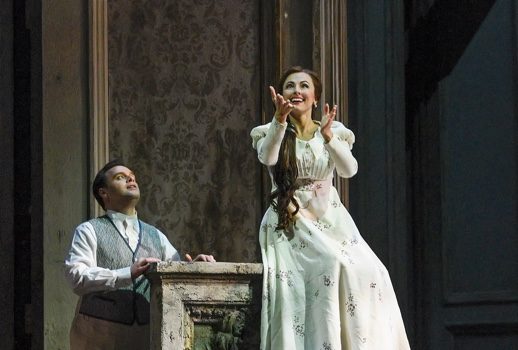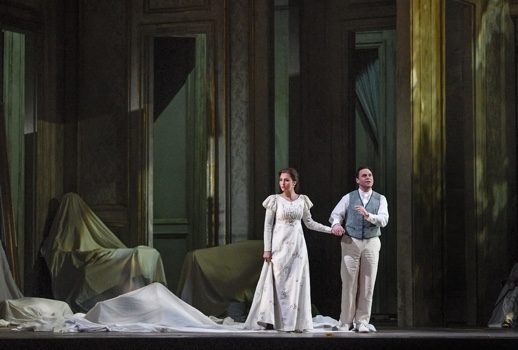

That unusual feature was once again strikingly demonstrated on Tuesday when the ravishing yet elusive opera returned to the Met and the lamentably faceless combination of Paul Appleby and Isabel Leonard were obliterated by Kyle Ketelsen’s searing Golaud.
He, in collaboration with conductor Yannick Nézet-Séguin who may still be finding his way into this sui generis work, dominated an intermittently gripping revival of Jonathan Miller’s relentlessly gloomy and monochromatic 1995 production.
Truth be told Debussy is not a composer I relish; I tend to successfully avoid his orchestral works and approach Pelléas with a mixture of fascination and dread. And, sure enough, at the first intermission last night I glumly chewed my brownie not at all looking forward to the next three acts.
But as before I had momentarily forgotten how the opera becomes transformed when sex and violence invade the unhappy land of Allemonde. After two acts of misty ambiguity, Debussy’s rapturous setting of Maeterlinck’s fetishized riff on the balcony scene from Romeo and Juliet pushes the opera into riveting focus.
We immediately realize that the sometimes maddeningly evanescent love between a man and his brother’s wife will inexorably lead to fatal consequences.
In the hypnotic third and fourth acts, Nézet-Ségun’s conducting blossomed: he and his inspired orchestra were most at home in the opera’s surging pages of passion and jealousy. Despite A. Jesse Schopflocher’s more than usually squeaky, often inaudible Yniold, Ketelsen made Golaud’s brutal questioning of his son and their harrowing spying on the lovers the evening’s devastating high points.
What a difference an act makes: I couldn’t wait for the second intermission to end to get back to witness the tortured brother/husband’s impetuous vengeance.
After the remarkably involving fourth act, Mélisande’s long deathbed scene couldn’t help but be an anticlimax. Was it just coincidence that the Met’s repertory lately has been dominated by operas in which the heroines endure painfully attenuated death scenes: La Traviata, Adriana Lecouvreur, and now Pelléas!
We are denied in Debussy the catharsis that other tragic works offer: Golaud must live with the wrenching guilt of his actions and his unconfirmed suspicions while his newborn daughter will grow up in a world of inescapable sadness.

The forest where Golaud first encounters the lost, inscrutable Mélisande looks much like the castle garden or the well in the nearby park where Mélisande carelessly loses her wedding ring. This lack of visual variety transforms the work into something more hopelessly oppressive than it might be.
Within Miller/Conklin’s gray world it becomes particularly incumbent upon the star-crossed would-be lovers to project a mystery and a charisma that will draw in the audience. Ultimately, that was Tuesday’s biggest weakness as both Leonard and Appleby in particular failed to fascinate.
The beauteous mezzo, who has always struck me as a capable if generic artist, had a genuine breakthrough in the fall with the tailor-made title role of Nico Muhly’s Marnie in which she made the evasive title character pathetic and moving.
Unfortunately, her mature, increasingly rich voice and regal demeanor were all wrong for the young neurasthenic mystery woman. Her most striking moment was a surprising one: after being sadistically berated by her husband, her prostrate Mélisande refused the offered hand of a servant and struggled to her feet by herself and slowly exited with a stunned, crushed nobility.
A cruelly miscast Appleby often suggested Pelléas was a boyishly clueless Candide who had taken the wrong turn on his way back to Westphalia. A tenor rather than the usual high baritone, he struggled throughout with the role’s lowish tessitura only finding real ease in some of the soaring phrases of the balcony scene.
Eventually he came to real grief in his final encounter with Mélisande where he cracked and then omitted or took down some music struggling just to finish the act. It was a dishearteningly awkward end to an unfortunate portrayal. I couldn’t help but think of young baritones who might have instead excelled in the role, perhaps John Brancy, whom I met during the first intermission?
I first heard French-Canadian contralto Marie-Nicole Lemieux 15 years ago performing a Vivaldi opera in Paris. Although she continues to occasionally sing baroque music, she has moved into heavier repertoire more recently including Cassandre, Carmen and Dalila.
In her modest belated Met debut as Geneviève she was a bit unsteady in her letter-reading scene but settled down for a sunny interchange with Mélisande in the garden. Mistress Quickly in the revival of Falstaff next month will likely give Met audiences a better idea of her talents.

Following the magnificent José van Dam and Gerald Finley, Ketelsen seized Golaud’s interesting and complex character and compelled the audience with his every appearance each time he jolting the performance alive with his full rich voice, wonderfully clear diction and intensely subtle dramatic commitment.
Cruel yet pitiable, his Golaud offered a gratifyingly nuanced traversal of a role that can seem one-dimensional. His frustratingly infrequent Met career has been mostly limited to lots of performances of Escamillo in Carmen but one hopes that this superb Debussy outing will be a harbinger of more varied and prominent appearances in the near future.
Perhaps Nézet-Séguin might have preferred to delay his first Met Pelléas until more fortuitous circumstances: a new production with a cast that suggested less of the former Music Director’s tastes and more of his own.
But he graciously stepped forward (his schedule presumably precluded his leading this production’s final performance on January 31) and drew sumptuous playing from his band and brought a sizzling intensity to the score’s most dramatic moments. Maybe it didn’t quite jell as a whole but many individual moments were eminently cherishable.
It’s likely that subsequent performances will show maturation but there’s only so much that can happen given his unsatisfying protagonists. I imagine his next Met outing will offer a less compromised result: Poulenc’s Les Dialogues des Carmélites with Leonard, Karita Mattila, Adrianne Pieczonka and Erin Morley beginning May 3.
But before that, Pelléas audiences should next week check out Mélisande’s first husband at home in Bartók’s Bluebeard’s Castle—it’ll explain a lot!
Photos: Karen Almond























Comments